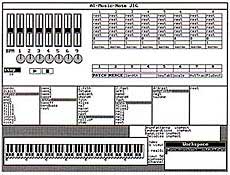 |
| Computer Music Journal |
Always something technically interesting. Having said that, I rarely found any of the music interesting. I usually avoided the concerts at the ICMC. I'd go in thinking it might be better this time, but , no they never were.
At the time I was going to the ICMCs I also very involved with Smalltalk and the Lisp systems that were in vogue. These were music construction workbenches. I developed my own research system in Smalktalk /V that talked with MIDI and DSP hardware.
I haven't done much along those lines recently, and basically find Reaper ,VST based instruments and effects mixed with real guitar and bass to be effective and productive.
But musical inspiration is a very strange thing. The things I have done just come from somewhere. A mash of what I've heard over a life time mixed with what I have the ability to play, and the instrumentation I do, I expect. And some times inspiration just doesn't happen. I have quite a few tracks that are works in progress (WIP) that I just stopped working on as they were just rubbish, and didn't say anything to me.
Now, Computer assisted composition is still an interest. Riff-ology and my own AIMusicBook looked very much like GarageBand does today, decades later. I didn't use sampled phrases though, but midi phrases, either entered into a database or algorithmically generated. It was amazing how 1/f noise (actually random numbers) filtered and constrained to a scale makes interesting melodies.
 |
| AIMusicBook |
This shot of AIMusicBook shows a scale on the keyboard, the central phrase selection and area (very much like in EZDrummer today) and a sequencer section top right. This was all Smalltalk/V so executing code in the Workspace window was all part of the fun as much as the graphical controls.
Jan Hammer used algorithmic tools to help with doing the Miami Vice soundtrack stuff. He used the far from sexy Dr. T Software on a Commodore 64. Or rather just the Algorithmic Composer, Phrase Generator that he recorded into another sequencer (Magnetic Music's Texture on a IBM PC). See Keyboard magazine June 1987, page 51.
 |
| Tunesmith |
Now the thing about Jan Hammers, music is that it is something I do listen to, still listen to, unlike the ICMC stuff. Shall we say it is an issue of taste and style.
At that time there was also algorithmic composition software M and Jam Factory on the Mac. None of those software tools are available now. David Cope has also done classical composition, but again in an academic environment.
Maybe the option of computer assisted composition targeted at rock, metal, dance, techno etc is an option again in the current VST DAW world? The KARMA system was licensed by Korg and put in some of their workstations, but is not available in any DAW compatible form. There are enough sampled phrase based music construction kits around to show there is a market.
I just don't know if it is big enough to be a business. I do know that selling it from our own website that is possible now, removes the huge barrier of distribution and "available shelf space" that were a problem in 1987.
Contact us at Art & Technology.

No comments:
Post a Comment